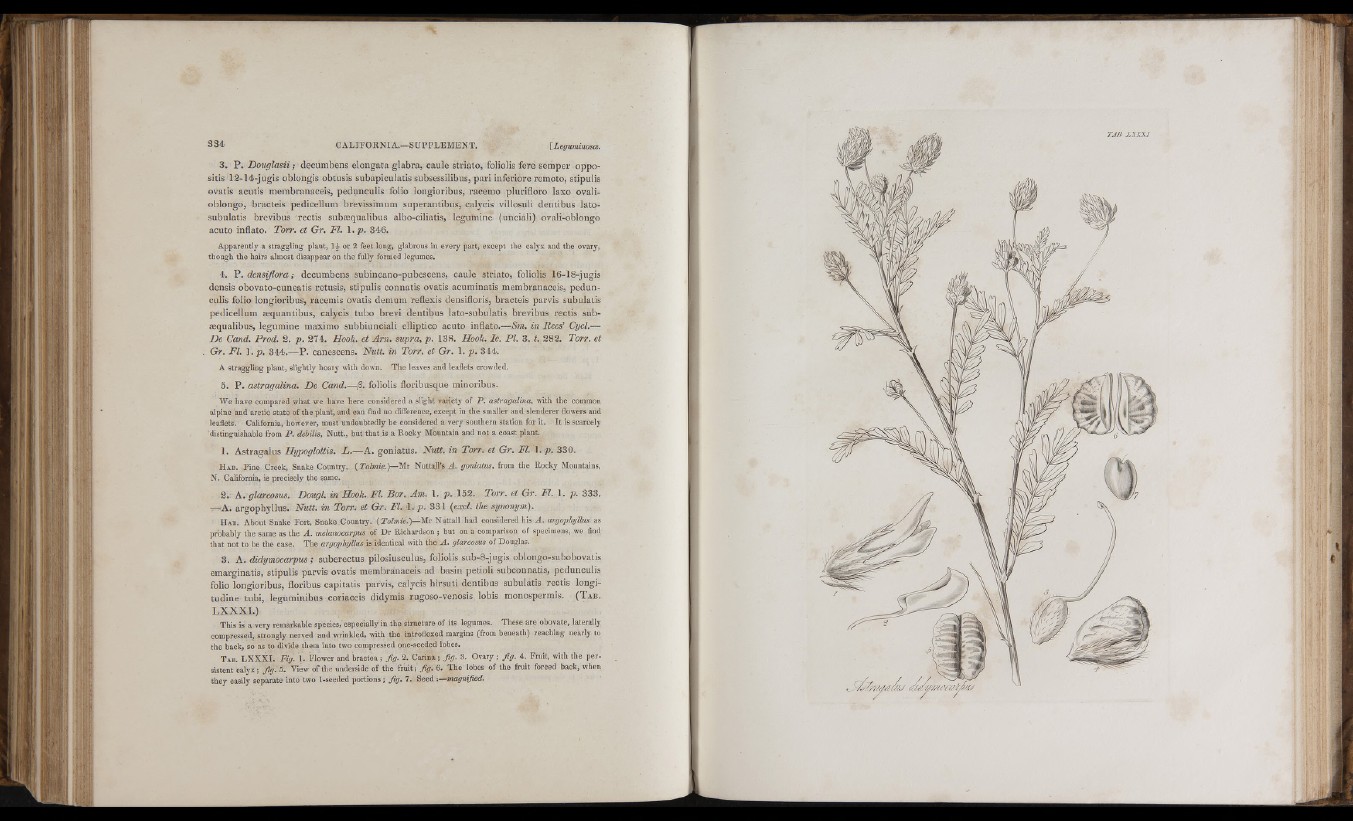
3. P . Do u g la sii; decumbens elongata glabra, caule striato , foliolis fere semper oppositis
12-14-jugis oblongis obtusis subapiculatis subsessilibus, p a ri inferiore remoto, stipulis
ovatis acutis membranaceis, pedunculis folio longioribus, racemo plurífloro laxo ovaîi-
oblongo, bracteis pedicellum brevissimum superantibus, calycis villosuli dentibus lato-
subulatis brevibus rectis subæqualibus albo-ciliatis, legumine (unciali) ovali-oblongo
acuto inflato. Torr. et Gr, F l. l . p . 346.
Apparently a straggling plant, 1¿- or 2 feet long, glabrous in every part, except the calyx and the ovary,
though the hairs almost disappear on the fully formed legumes.
4. P . d e n s ifo ra ; decumbens subincano-pubescens, caule striato, foliolis 16-18-jugis
densis obovato-cuneatis retusis, stipulis connatis ovatis acuminatis membranaceis, p e d u n culis
folio longioribus, racemis ovatis demum reflexis densifloris, bracteis parvis subulatis
pedicellum æquantibus, calycis tu b o brevi dentibus lato-subulatis brevibus rectis subæqualibus,
legumine maximo subbiunciali elliptico acuto inflato.—Sm. in Rees’ Cycl.—
D e Cand. Prod. 2. p . 274. Hook, et A rn . supra, p . Ì38. Hook. Ic. PI. 3. t. 282. Torr. et
. Gr. F L l . p . 344.— P . canescens. Nutt, in Torr. et Gr. 1. p . 344.
A straggling plant, slightly hoary with down. Tho leaves and leaflets crowded.
5. P . astragalina. De Cand.—fi. foliolis floribusque minoribus.
We have compared what we have here considered a slight variety of P . astragalina, with the common
alpine and arctic state of the plant, and can find no difference, except in the smaller and slenderer flowers and
leaflets. California, however, must undoubtedly be considered a very southern station for it. It is scarcely
distinguishable from P . debilis, Nutt., but that is a Rocky Mountain and not a coast plant.
1. Astragalus Hypoglottis. L .—A. goniatus. N u tt, in Torr. et Gr. FL I. p . 330.
H a b . Pine Creek, Snake Country. (Tolmie.)— Ur Nuttall’s Æ goniatus, from the Rocky Mountains,
N. California, is precisely the same.
2 . A. glareosus. Dougl. in Hook. Fl. Bor. Am. 1. p . 152. Torr. ei Gr. PL 1. p. 333.
— A. argophyllus. N u tt, in Torr. et Gr. FL 1. p . 331 {excl. the synonym).
H a b . About Snake Fort, Snake Country. {Tolmie.)— Ux Nuttall had considered his A . argophyllus as
probably the same as the A . melanocarpus of Dr Richardson ; but on a comparison of specimens, we find
that not to be the case. The argophyllus is identical with the A . glareosus of Douglas.
3. A. didymocarpus ; suberectus pilosiusculus, foliolis sub-8-jugis oblongo-subobovatis
emarginatis, stipulis parvis ovatis membranaceis ad basin petioli subconnatis, pedunculis
folio longioribus, floribus capitatis parvis, calycis hirsuti dentibus subulatis rectis longitu
d in e tubi, leguminibus coriaceis didymis rugoso-venosis lobis monospermis. (T a b .
LX X X I.)
This is a very remarkable species, especially in the structure of its legumes. These are obovate, laterally
compressed, strongly nerved and wrinkled, with the introflexed margins (from beneath) reaching nearly to
the back, so as to divide them into two compressed one-seeded lobes.
T ab . LXX XI. Fig. 1. Flower and bractea ; Jig. 2 . Carina ; fig . 8. Ovary ; fig . 4 , Fruit, with the per-
sistent calyx; fig . 5. View of the underside of the fruit; fig. 6. The lobes of the fruit forced back, when
they easily separate into two I-seeded portions ; fig . 7. Seed :—magnified.
. > L 7 n rM / / / j / / / r / / / / / / y,Y y//i9